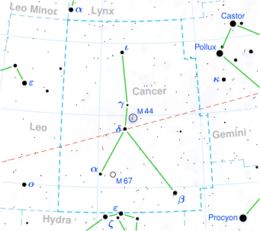Astronomy:Iota Cancri
| Observation data {{#ifeq:J2000.0|J2000.0 (ICRS)|Epoch J2000.0 Equinox J2000.0 (ICRS)| [[History:Epoch|Epoch J2000.0]] [[Astronomy:Equinox (celestial coordinates)|Equinox J2000.0}} | |
|---|---|
| Constellation | Cancer |
| ι Cnc A | |
| Right ascension | 08h 46m 41.81988s[1] |
| Declination | +28° 45′ 35.6190″[1] |
| Apparent magnitude (V) | 4.02[2] |
| ι Cnc B | |
| Right ascension | 08h 46m 39.98118s[1] |
| Declination | +28° 45′ 54.1932″[1] |
| Apparent magnitude (V) | 6.57[3] |
| Characteristics | |
| Spectral type | G8IIIa Ba0.2[4] + A2V[5] |
| Astrometry | |
| ι Cnc A | |
| Radial velocity (Rv) | 15.74 ± 0.13[6] km/s |
| Proper motion (μ) | RA: -21.58 ± 0.75[1] mas/yr Dec.: -45.69 ± 0.56[1] mas/yr |
| Parallax (π) | 9.85 ± 0.61[1] mas |
| Distance | 330 ± 20 ly (102 ± 6 pc) |
| Absolute magnitude (MV) | −0.79[7] |
| ι Cnc B | |
| Radial velocity (Rv) | 25.00 ± 1.5[8] km/s |
| Proper motion (μ) | RA: -22.74 ± 3.45[1] mas/yr Dec.: -46.36 ± 2.56[1] mas/yr |
| Parallax (π) | 11.69 ± 2.75[1] mas |
| Distance | approx. 280 ly (approx. 90 pc) |
| Details | |
| ι Cnc A | |
| Mass | 3.43[9] M☉ |
| Radius | 21[6] R☉ |
| Luminosity | 204[6] L☉ |
| Surface gravity (log g) | 2.5[6] cgs |
| Temperature | 4,954[7] K |
| Metallicity [Fe/H] | −0.14[6] dex |
| Rotational velocity (v sin i) | 170[10] km/s |
| ι Cnc B | |
| Luminosity | 14.39[11] L☉ |
| Temperature | 8,786[11] K |
| Age | 263[9] Myr |
| Other designations | |
48 Cancri | |
| Iota Cancri A: HR 3475, HD 74739, BD+29°1824, HIP 43103, SAO 80416 | |
| Iota Cancri B: HR 3474, HD 74738, BD+29°1823, HIP 43100, SAO 80415 | |
| Database references | |
| SIMBAD | data |
Iota Cancri (ι Cnc, ι Cancri) is a double star in the constellation Cancer approximately 300 light years from Earth.
The two stars of ι Cancri are separated by 30 arcseconds, changing only slowly. Although no orbit has been derived, the two stars show a large common proper motion and are assumed to be gravitationally related.[12]
The brighter star, ι Cancri A, is a yellow G-type giant with an apparent magnitude of +4.02. It is a mild barium star, thought to be formed by mass transfer of enriched material from an asymptotic giant branch star onto a less evolved companion. No such donor has been detected in the ι Cancri system, but it is assumed that there is an unseen white dwarf.[13]
The fainter of the two stars, ι Cancri B, is a white A-type main sequence dwarf with an apparent magnitude of +6.57. It is a shell star, surrounded by material expelled by its rapid rotation.[14]
References
- ↑ 1.0 1.1 1.2 1.3 1.4 1.5 1.6 1.7 1.8 1.9 Van Leeuwen, F. (2007). "Validation of the new Hipparcos reduction". Astronomy and Astrophysics 474 (2): 653–664. doi:10.1051/0004-6361:20078357. Bibcode: 2007A&A...474..653V.
- ↑ Mermilliod, J.-C. (1986). "Compilation of Eggen's UBV data, transformed to UBV (unpublished)". Catalogue of Eggen's UBV Data. Bibcode: 1986EgUBV........0M.
- ↑ Ducati, J. R. (2002). "VizieR Online Data Catalog: Catalogue of Stellar Photometry in Johnson's 11-color system". CDS/ADC Collection of Electronic Catalogues 2237. Bibcode: 2002yCat.2237....0D.
- ↑ Keenan, Philip C.; McNeil, Raymond C. (1989). "The Perkins catalog of revised MK types for the cooler stars". Astrophysical Journal Supplement Series 71: 245. doi:10.1086/191373. Bibcode: 1989ApJS...71..245K.
- ↑ Grenier, S.; Baylac, M.-O.; Rolland, L.; Burnage, R.; Arenou, F.; Briot, D.; Delmas, F.; Duflot, M. et al. (1999). "Radial velocities. Measurements of 2800 B2-F5 stars for HIPPARCOS". Astronomy and Astrophysics Supplement 137 (3): 451. doi:10.1051/aas:1999489. Bibcode: 1999A&AS..137..451G. https://hal.archives-ouvertes.fr/hal-02053966/file/Grenier%20et%20al.%20-%201999%20-%20Radial%20velocities.%20Measurements%20of%202800%20B2-F5%20star.pdf.
- ↑ 6.0 6.1 6.2 6.3 6.4 Massarotti, Alessandro; Latham, David W.; Stefanik, Robert P.; Fogel, Jeffrey (2008). "Rotational and Radial Velocities for a Sample of 761 HIPPARCOS Giants and the Role of Binarity". The Astronomical Journal 135 (1): 209–231. doi:10.1088/0004-6256/135/1/209. Bibcode: 2008AJ....135..209M.
- ↑ 7.0 7.1 Kovtyukh, V. V.; Chekhonadskikh, F. A.; Luck, R. E.; Soubiran, C.; Yasinskaya, M. P.; Belik, S. I. (2010). "Accurate luminosities for F-G supergiants from FeII/FeI line depth ratios". Monthly Notices of the Royal Astronomical Society 408 (3): 1568. doi:10.1111/j.1365-2966.2010.17217.x. Bibcode: 2010MNRAS.408.1568K.
- ↑ Gontcharov, G. A. (2006). "Pulkovo Compilation of Radial Velocities for 35 495 Hipparcos stars in a common system". Astronomy Letters 32 (11): 759–771. doi:10.1134/S1063773706110065. Bibcode: 2006AstL...32..759G.
- ↑ 9.0 9.1 Takeda, Yoichi; Sato, Bun'ei; Murata, Daisuke (2008). "Stellar Parameters and Elemental Abundances of Late-G Giants". Publications of the Astronomical Society of Japan 60 (4): 781. doi:10.1093/pasj/60.4.781. Bibcode: 2008PASJ...60..781T.
- ↑ Royer, F.; Grenier, S.; Baylac, M.-O.; Gómez, A. E.; Zorec, J. (2002). "Rotational velocities of A-type stars in the northern hemisphere. II. Measurement of v sin i". Astronomy and Astrophysics 393 (3): 897–912. doi:10.1051/0004-6361:20020943. Bibcode: 2002A&A...393..897R.
- ↑ 11.0 11.1 McDonald, I.; Zijlstra, A. A.; Boyer, M. L. (2012). "Fundamental parameters and infrared excesses of Hipparcos stars". Monthly Notices of the Royal Astronomical Society 427 (1): 343–357. doi:10.1111/j.1365-2966.2012.21873.x. Bibcode: 2012MNRAS.427..343M.
- ↑ Eggen, Olin J. (1994). "Photometry of F-K type bright giants and supergiants. 3: The luminosity, reddening, and heavy element abundance of GK stars". The Astronomical Journal 107: 2184. doi:10.1086/117030. Bibcode: 1994AJ....107.2184E.
- ↑ Eggleton, P. P.; Tokovinin, A. A. (2008). "A catalogue of multiplicity among bright stellar systems". Monthly Notices of the Royal Astronomical Society 389 (2): 869. doi:10.1111/j.1365-2966.2008.13596.x. Bibcode: 2008MNRAS.389..869E.
- ↑ Hauck, B.; Jaschek, C. (2000). "A-shell stars in the Geneva system". Astronomy and Astrophysics 354: 157. Bibcode: 2000A&A...354..157H.
 |



